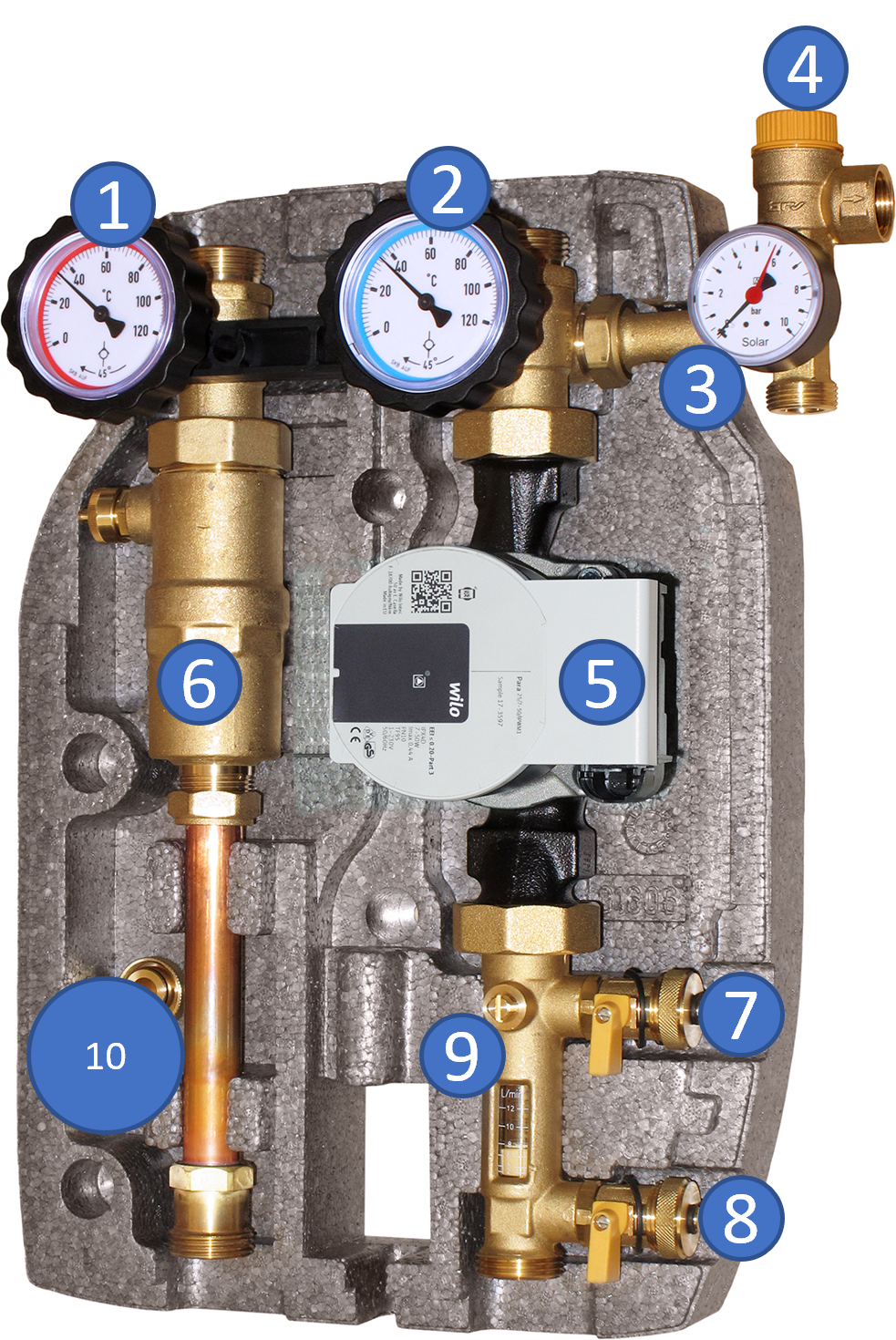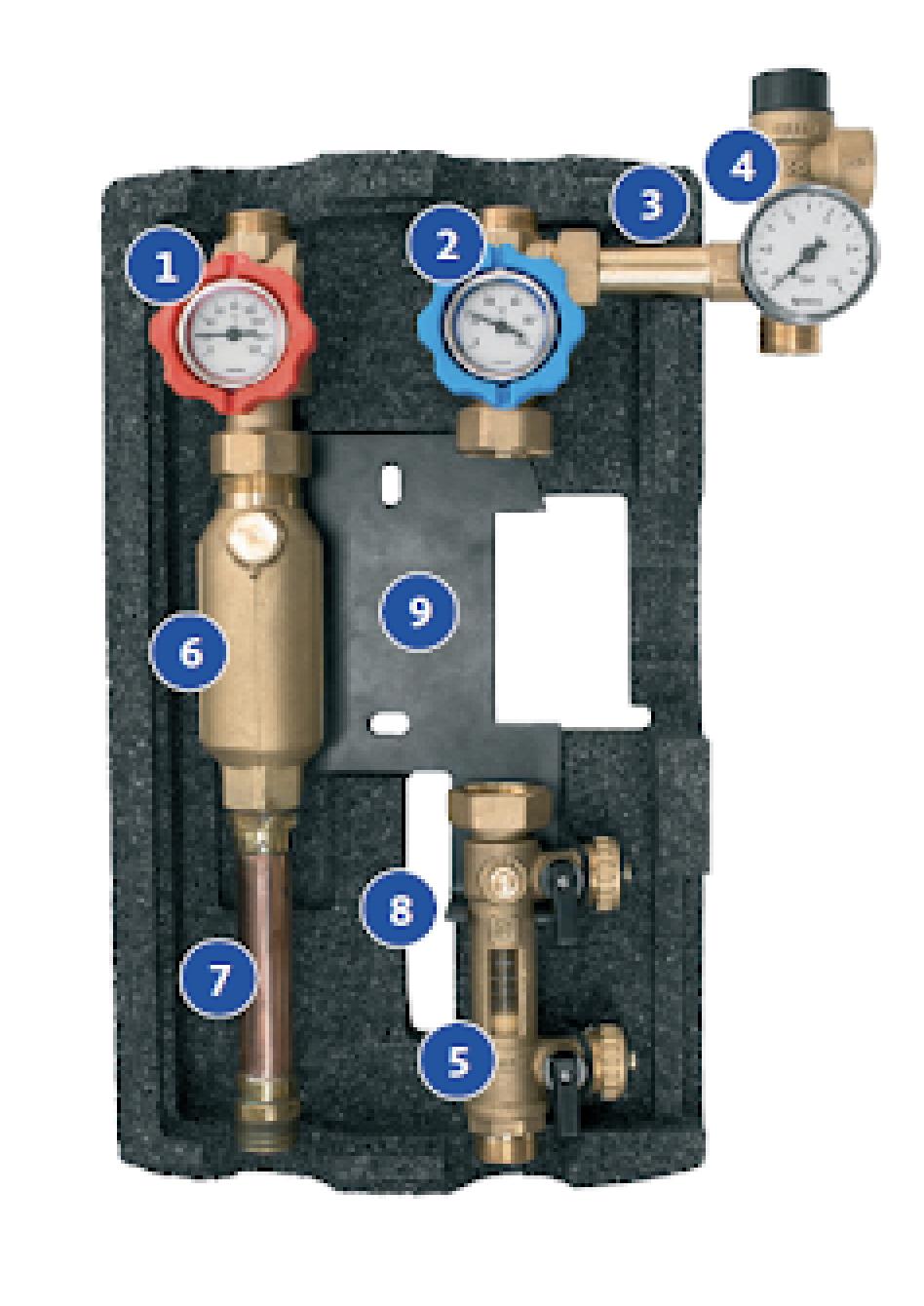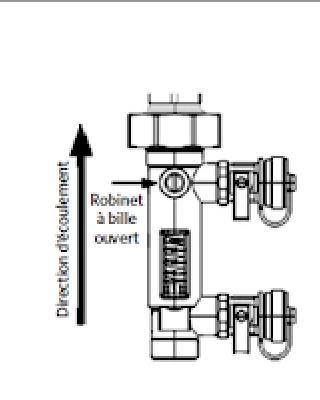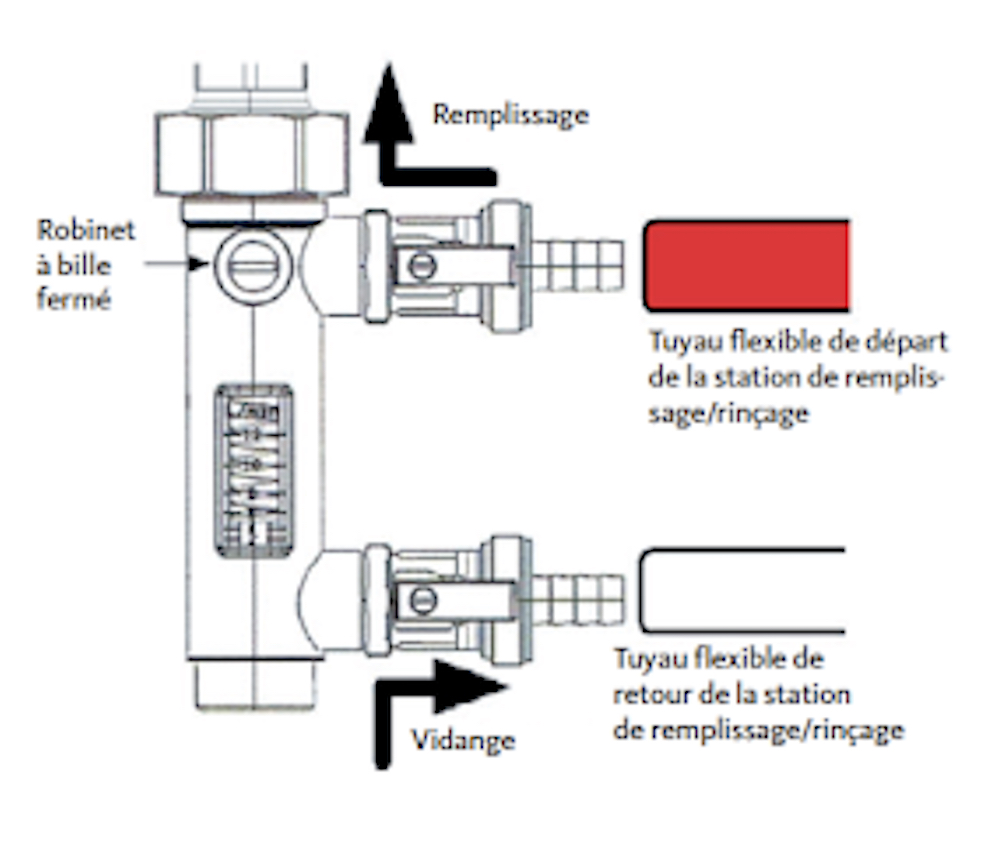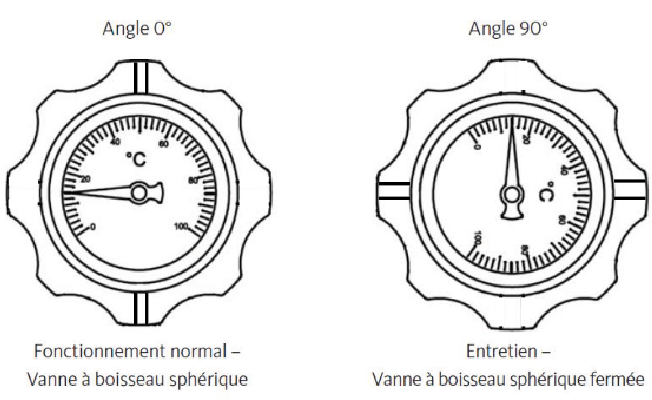How to set the pressure during commissioning with the OEG control group or Thermador?
We detail below the steps to set the pressure during commissioning with the OEG control group or Thermador.
As a reminder, (as summarized in this article) whatever your hardware, the steps to commission a pressurized system with Dualsun SPRING panels are as follows:
Filling with water
Glycol filling
Pressure adjustment
Flow adjustment
Setting the back-up
Commissioning of the hydraulic circuit
Whether for the OEG group or the Thermador group, the steps are the same, products are slightly different but the principle is the same:
Description group Thermador
1. Return shut-off ball valve with built-in thermometer and anti-thermosiphon valve
3. Pressure gauge and expansion tank drain
7. Fill valve 8. Drain valve 9. Flow meter with valves for filling (7) and draining (8) the solar system 10. Copper tube with brass fitting |
Description group OEG
1. Return shut-off ball valve with built-in thermometer and anti-thermosiphon valve
3. Pressure gauge and expansion tank drain
|
1- Glycol filling
To fill and degas the solar system, you can use a solar filling station with a volume flow of 12 l/min and a delivery height of 50m (e.g. rinsing and filling station SBS 2000).
To commission the installation, follow these steps:
During the entire commissioning, do not supply the solar station
Make a first filling with water, in order to identify any leaks
Fill the glycol water tank, ensuring that it is clean.
Connect the transparent hose to the degasser and put it inside the tank of the filling station.
Connect the flexible pipes from the filling station to the level of the filling (7) and emptying (8) valves on the hydraulic unit as indicated above
Translation: Robinet à bille fermé = ball valve closed Remplissage = filling tuyau flexible de départ de la station de remplissage/rinçage = flexible filling/rinsing station outlet hose Tuyau flexible de retour de la station de remplissage rinçage = flexible filling/rinsing station inlet hose Vidange = Emptying
|
Close the valve on the flow meter so that the cavity on the ball valve flow meter is in a horizontal position (see illustration).
Start the filling station.
Open the drain valve.
Gradually open the filling valve, taking care not to exceed the maximum admissible pressure of 2 bars in the panels (pressure at the level of the pressure gauge of the solar station such that: p < pmax=2+H/10, where H is the height between the solar station and the top of the panels).
Check the glycol level in the filling station reservoir. Add fluid, if needed. The solar liquid must circulate for at least 30 minutes before the transparent flexible tube at the back of the filling station no longer indicates air bubbles in the solar liquid.
During this time, check the tightness of the system.
Turn the valve of the flowmeter for one minute to pass part of the fluid through the circulator (Wilo pump).
Return the flow meter valve to horizontal
After checking that the solar liquid returns clearly to the tank, carry out “water hammering”. For that :
Close the degasser
Lower the pressure between 1 and 1.5 bar by slightly closing the filling valve
Completely close the return valve.
The pressure increases on the pressure gauge, once it reaches the maximum allowable pressure (pmax=2+H/10), fully open the drain valve.
Raise the pressure to approximately 2 bars.
Open the degasser.
Observe the gassing of air at the transparent tube.
Repeat this procedure until the pressure quickly reaches the maximum pressure pmax after closing the return valve and there are no more air bubbles escaping from the degasser.
2- Pressure adjustment
Determine the operating pressure p to be adjusted: p = 1.5 + H/10.
For simplicity, move the pressure indicator to this pressure.
Close the degasser permanently
Lower the pressure between 1 and 1.5 bar by slightly closing the filling valve
Completely close the drain valve
The pressure increases: close the filling valve once the pressure gauge reaches the pressure p to be adjusted.
If the valve was closed too soon and the pressure is too low: reopen the filling valve slightly then close it.
If the valve was closed too late and the pressure is too high: reopen the drain valve, then the filling valve and repeat the operation.
Once the correct pressure is set, stop the filling station
Check that both flow meter valves are closed.
Translation: Robinet à bille fermé = ball valve closed Remplissage = filling tuyau flexible de départ de la station de remplissage/rinçage = flexible filling/rinsing station outlet hose Tuyau flexible de retour de la station de remplissage rinçage = flexible filling/rinsing station inlet hose Vidange = Emptying |
For filling and degassing the solar system, you can, for example, use a solar filling station with a volume flow of 12 l/min and a delivery height of 50 m.
Make sure that the solar liquid is filled only in a clean tank.
Vent the flexible hose from the station.
Connect the flexible hose as shown below with the pump group.
Close the valve on the flow meter so that the cavity on the ball valve flow meter is in the horizontal position (see illustration).
Translation: Fonctionnement normal - Vanne à boisseau sphérique = Normal operation - ball valve Entretien - Vanne à boisseau sphérique fermée = servicing - ball valve closed |
Start the pump and open the shut-off valve in the flow and return. Check the glycol level in the filling station reservoir. Add fluid, if needed. The solar liquid must circulate for at least 30 minutes before the transparent flexible tube at the back of the filling station no longer indicates air bubbles in the solar liquid.
During this time, check the tightness of the system.
After checking that the solar liquid returns clearly to the tank, you should continue with the so-called "water hammer". The return valve must be closed when the pump on the filling station is running. The pressure gauge on the pump set indicates an increase in pressure. This gradual increase in pressure demonstrates that there is no air coming out of the solar system. A rapid opening of the return valve causes a drop in pressure. Repeat this procedure until the pressure quickly reaches the maximum value of 1.5 bar + H/10 after closing the return valve.
Remove the flexible pipes from the solar station, put the regulating valve on the flow meter in a vertical position, close the shut-off valves on the flow meter (see illustration). The pump group is now ready for flow adjustment.The flow rate is read on the lower edge of the float.
Unlike the Dualsun solar station, it is not necessary during commissioning to close the blue valve (ball valve no. 2).
To learn more, go to our article : How to carry out a hydraulic commissioning with Dualsun SPRING panels?

